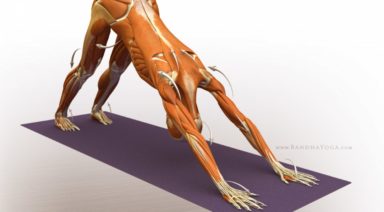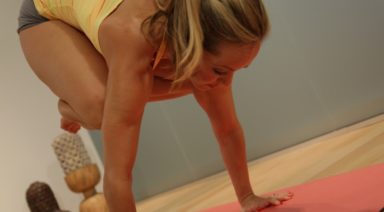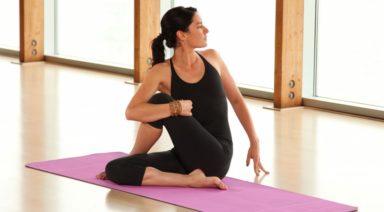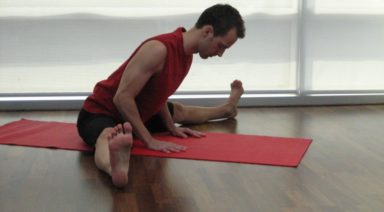Legs-up-the-Wall | Yoga Pose

ADJUSTMENTS | BENEFITS | CONTRAINDICATIONS | MANTRA | MUDRA | PREP POSES | SANSKRIT | STEPS | TIPS
Viparita karani (vip-par-EE-tah car-AHN-ee), or legs-up-the-wall pose, is a restorative inversion that can ease the mind and relieve painful symptoms such as tension and cramps. Many people enjoy this pose using props — you may want to have a pillow, bolster, or folded blanket nearby.

ADJUSTMENTS/MODIFICATIONS:
- This pose may be enjoyed using props like a pillow, bolster, or folded blanket under your hips.
- To stretch your inner thighs and groin muscles, let your feet fall out to the sides so your legs make a wide “V” shape.
- If you neck is sore, place a rolled up blanket under your neck or a pillow under your head.
CONTRAINDICATIONS AND CAUTIONS:
Although this is a mild, restorative posture, it is still considered an inversion. While many teachers recommend legs-up-the-wall pose as a therapeutic posture, please check with your doctor if you are experiencing any of the following:
- Menstruation
- Pregnancy
- Glaucoma
- High Blood Pressure
TIPS:
Use a blanket or pillow under your hips to release any tension in the lower back.
Place a blanket on the soles of your feet for a grounded sensation.
No wall? Place a block or blanket under your hips and stretch your legs up to the sky, finding a place where your legs feel almost weightless.
STEP BY STEP:
- Find an open wall space. Start seated beside the wall, with shoulder and hip touching the wall. On an exhale, gently lie down on your back and pivot yourself so that the backs of your legs press against the wall and the bottoms of your feet face upward. You may need to wiggle around to find your way into this position.
- With your sitting bones pressed up against the wall, or slightly away from the wall, rest your back and head on the floor; this will form an approximate 90-degree angle with your body.
- If you find this position uncomfortable in any way, or just wish for extra cushion, you can use your prop here. By pressing the bottoms of your feet into the wall, lift your hips slightly, and slide your prop underneath your hips.
- Let the back of your head feel heavy with your neck in a neutral position. Soften your face and your throat. Let your hands rest face-down on your belly or face-up along the sides of your torso. Close your eyes and breathe deeply through your nose.
- Stay here for anywhere from five to 15 minutes. To come out of the position, push the bottoms of your feet into the wall and lift your hips slightly. Remove your props. Gently roll to one side for a few breaths before returning to your seat.

PREPARATORY POSES:
Viparita Karani is usually a restorative pose, performed near the end of a practice, but it can easily be practiced as a pose by itself. Preparations include:
- Bridge pose | Setu bandha sarvangasana
- Standing forward fold | Uttanasana
FOLLOW-UP POSES:
- Savasana
SANSKRIT:
- Viparita: reversed/inverted
- Karani: doing/action
- Asana: pose
PHYSICAL BENEFITS:
- Offers relief from symptoms of arthritis, headaches, high/low blood pressure, and insomnia.
- Eases symptoms of PMS and menopause.
- Relieves tired, cramped feet and legs.
- Gently stretches the hamstrings, legs and lower back.
- Relieves lower back pain.
ENERGETIC BENEFITS:
- Calms the mind.
- Eases anxiety and stress.
MANTRA:
“RA MA DA SA SA SAY SO HUNG”
A well-known mantra used to stimulate the body’s natural ability to heal itself, this mantra connects us with the healing abilities of the earth and universe at large. Reciting this mantra can help strengthen the immune system while calming the nervous system, easing you into a calm state of healing. It also represents the strengthening and healing of the mind and emotions.
MUDRA: SURYA MUDRA
Surya mudra (gesture of the sun) represents life, rejuvenation, and health. Bend the ring finger to the palm and place the thumb on top of the ring finger.
Benefits:
- Helps the digestive organs and relieves indigestion.
- Holistically boosts metabolism.
- Gives revitalized energy and strength to the nervous system.
- Sharpens the center within the thyroid gland.
- Relieves symptoms of anxiety.
Legal Disclaimer Before participating in any exercise program or using any fitness products or services that may be described and/or made accessible in or through the Gaia Website and/or the Services, you should consult with a physician or other healthcare provider. Read more about Gaia’s Terms Of Use.
Discipline & Surrender: The Art of Down Dog

I’m a yoga teacher who’s been teaching for over 20 years and doing down dog every day. So technically I can do the pose, but because of a pinched nerve in my elbow I’ve developed a problem akin to tennis elbow and it hurts like hell.
For years I’ve heard one student after another complain about down dog. They tell me it’s too hard, it’s boring and it sometimes hurts the hands and the feet. I would remind them about limitation, relaxing and letting go. “Breathe,” I would say.
I love down dog. It reminds me to surrender every part of my body to the pose. It requires discipline to first get into the pose and then a sense of surrender to maintain it. I remind my students that such is down dog, such is life. It takes discipline to stick to your goals and surrender to maintain them.
What I love about down dog is that it’s a one-for-all pose, meaning that it requires the integration of the whole body. It stretches the muscles of the back of the legs, shoulders, the belly and the back. It strengthens the arms, relieves neck tension and offers some of the benefits of inverted poses, such as cleaning the internal organs and relieving tension. It can be done for a warm up or a cool down.
Patanjali, who organized the knowledge of yoga into The Yoga Sutras of Patanjali, understood down dog. His book compiles 196 sutras that are essentially a road map for life. The second sutra, if fully understood, is enough to understand yoga. The rest of the sutras only serve to explain. Basically the second sutra is about the modification of the mind or the balance between the two qualities of abhyasa and variragya or “discipline” and “surrender.” This is down dog.
These two qualities form the foundation of yoga. It’s the balancing and the blending of the two opposing forces of discipline (practice) and surrender (letting go) that create harmony. It’s precisely the physical discipline of moving into down dog and the letting go so as to maintain it: that is why I love down dog, and why I was so disappointed when my body would no longer allow me to embrace the pose.
Not to be one to give up, I saw my doctor who sent me to a physical therapist. For six weeks I worked to relieve the pain in my elbow so that I could return to the mat. It also took discipline to faithfully make time to see the physical therapist three times a week. It took a sense of surrender to let go and remain unattached to the outcome of my therapy. My focus was to establish that sense of balance between abhyasa and variragya.
This process of therapy was a discovery that called upon me to transcend my ego. I’ve always prided myself on being able to easily slip in and out of down dog. My body has always been strong, flexible and resilient. Now my body was tired and worn, and I had to let go of my self-imposed boundaries and admit that I too had my limitations. I’m the yoga teacher and I cannot do a down dog?! But like all things in life, this too shall pass. Everything changes. With time and a little rest my elbow improved, and before I knew it, I was back on the mat in down dog with my students.
But something changed. I no longer take for granted that my body will always respond with the discipline I impose. Sometimes we need to pull back and surrender to the flow of life, even if that flow is one that is not so pleasant. As I like to remind my students, everything has an element of good. We just need to surrender to it and quietly learn to accept. In that, we will discover a sense of discipline and the ability to surrender; and if truly understood, this is enough to understand yoga. The resting of my elbow, like the remaining sutras, simply served to instill in me the importance of balance and the modification of the mind.











































